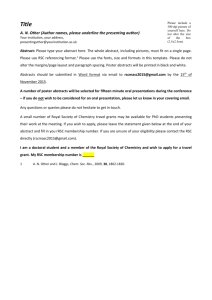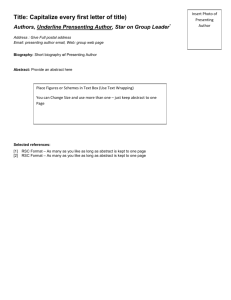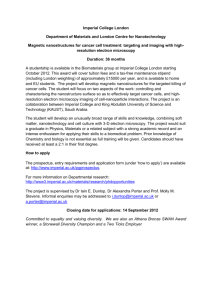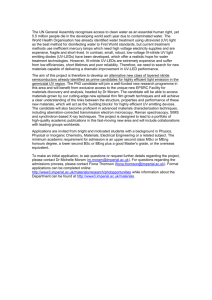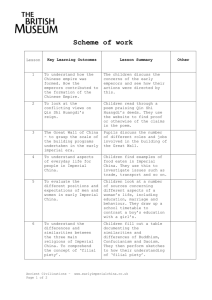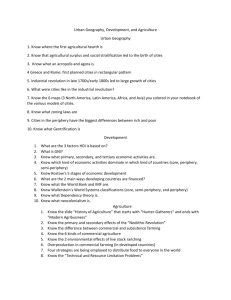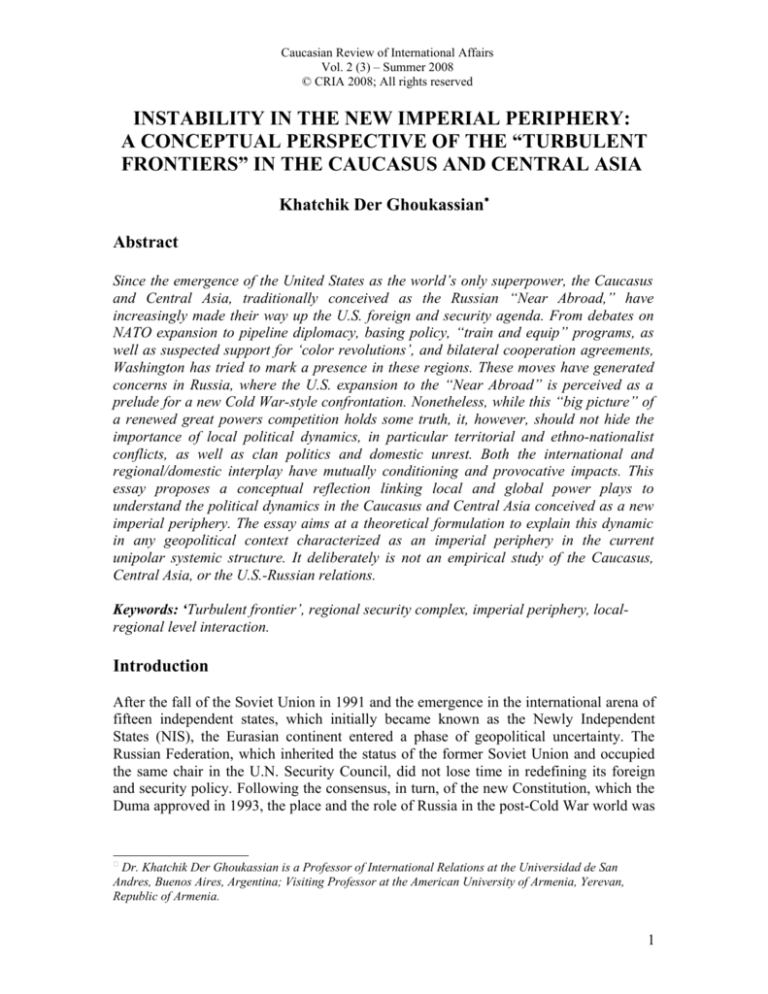
Caucasian Review of International Affairs
Vol. 2 (3) – Summer 2008
© CRIA 2008; All rights reserved
INSTABILITY IN THE NEW IMPERIAL PERIPHERY:
A CONCEPTUAL PERSPECTIVE OF THE “TURBULENT
FRONTIERS” IN THE CAUCASUS AND CENTRAL ASIA
Khatchik Der Ghoukassian∗
Abstract
Since the emergence of the United States as the world’s only superpower, the Caucasus
and Central Asia, traditionally conceived as the Russian “Near Abroad,” have
increasingly made their way up the U.S. foreign and security agenda. From debates on
NATO expansion to pipeline diplomacy, basing policy, “train and equip” programs, as
well as suspected support for ‘color revolutions’, and bilateral cooperation agreements,
Washington has tried to mark a presence in these regions. These moves have generated
concerns in Russia, where the U.S. expansion to the “Near Abroad” is perceived as a
prelude for a new Cold War-style confrontation. Nonetheless, while this “big picture” of
a renewed great powers competition holds some truth, it, however, should not hide the
importance of local political dynamics, in particular territorial and ethno-nationalist
conflicts, as well as clan politics and domestic unrest. Both the international and
regional/domestic interplay have mutually conditioning and provocative impacts. This
essay proposes a conceptual reflection linking local and global power plays to
understand the political dynamics in the Caucasus and Central Asia conceived as a new
imperial periphery. The essay aims at a theoretical formulation to explain this dynamic
in any geopolitical context characterized as an imperial periphery in the current
unipolar systemic structure. It deliberately is not an empirical study of the Caucasus,
Central Asia, or the U.S.-Russian relations.
Keywords: ‘Turbulent frontier’, regional security complex, imperial periphery, localregional level interaction.
Introduction
After the fall of the Soviet Union in 1991 and the emergence in the international arena of
fifteen independent states, which initially became known as the Newly Independent
States (NIS), the Eurasian continent entered a phase of geopolitical uncertainty. The
Russian Federation, which inherited the status of the former Soviet Union and occupied
the same chair in the U.N. Security Council, did not lose time in redefining its foreign
and security policy. Following the consensus, in turn, of the new Constitution, which the
Duma approved in 1993, the place and the role of Russia in the post-Cold War world was
Dr. Khatchik Der Ghoukassian is a Professor of International Relations at the Universidad de San
Andres, Buenos Aires, Argentina; Visiting Professor at the American University of Armenia, Yerevan,
Republic of Armenia.
1
Caucasian Review of International Affairs
Vol. 2 (3) – Summer 2008
© CRIA 2008; All rights reserved
defined in terms of a nuclear world power and a regional power with a special interest in
its Near Abroad, a concept that designed the former Soviet space.1
The Russian special interest in the Near Abroad was argued primarily for security
reasons. The rationale of this argument notwithstanding, the ‘hard power’ component of
the statement, and strong suspicions of a continuity of centuries-old imperial projection
did not make Moscow’s efforts to stabilize the region easy. Even before the fall of the
Soviet Union, and while the frozen nationalities question was reemerging from the
Caucasus to Central Asia and in the European regions of the multinational state (Carrère
d’Encausse 1991), Moscow, and the military in particular, was already intervening in the
conflicts. Moreover, when the Yeltsin government launched the initiative of a
Commonwealth of Independent State (CIS), Georgia, Azerbaijan, and Uzbekistan, among
others, showed reluctance and even resistance in joining the project. In fact, even after
signing up to it, emergence of the Georgia-Ukraine-Uzbekistan-Azerbaijan-Moldova
(GUUAM) alliance in the late 1990s, not mentioning the publicly admitted intention of
some of these countries to join the North Atlantic Treaty Organization (NATO), proved
how difficult it was for Russia to reassert its position as a regional hegemon.
With the fall of the Soviet Union, hence, the Near Abroad, or the former periphery of the
Soviet imperial state structure, developed a proper political dynamic appropriate to the
historical process of the emergence of the nation-state, including war, economic
transition and institutional building. By the mid-1990s, the initial conflictive phase of
defining territorial limits, the primary accumulation of capital and the internal power
struggle to dominate the state structures came to completion. While none of the conflicts
found its final solution and the emerging power structures were extremely weak, the
situation since then has been frozen.
The Near Abroad, hence, has entered a phase of turbulence, which seems more of a
domestic than inter-state nature - albeit some aspects of this turbulence, such as the socalled “color revolutions,” projected a power struggle that potentially went beyond the
internal logic of the events. The turbulence in the periphery, on the other hand, indicates
the irrelevance of the CIS as an institutional structure.
The fall of the Soviet Union opened the way to the expansion of U.S. influence in the
Eurasian landscape. Cautiously, during the Bush senior and Clinton administrations,
Washington never denied Moscow its right to mark a presence in the former Soviet
space, including as a factor of stabilization. Gradually, however, Washington’s interests
in the region started to take shape, leading to a competitive phase of U.S.-Russian
relations. The reemergence of the Caspian as a new ‘Black Gold’ Eldorado gave birth to a
political dynamic of pipeline diplomacy, with Washington pushing for a Mediterranean
route to world market for the oil, whereas Moscow remained eager to maintain export
routes under its control.
1
Aron, Leon , “Foreign Policy Doctrine of Postcommunist Russia”, in: Michael Mandelbaum (ed.), “The
New Russian Foreign Policy”, Council on Foreign Relations, Washington, DC. 1998.
2
Caucasian Review of International Affairs
Vol. 2 (3) – Summer 2008
© CRIA 2008; All rights reserved
Clinton’s foreign and security policy, conceptually defined along the guidelines of the
Engagement and Expansion doctrine, contemplated the reformulation of NATO’s role
and its eventual expansion to the East. The Russians never lost the opportunity to express
their hostility to this initiative, and perceived it in terms of a zero-sum game. Diplomatic
arrangements were eventually made for both issues, which, nevertheless, ended up
marking an increasing U.S. presence on the former Soviet territory outside Russia.
The end of the post-Cold War era on September 11, 2001 and the following declaration
of the War on Terrorism of the Bush administration strengthened this presence and gave
it a military aspect. The Republican administration in the White House soon endorsed a
hawkish vision of world affairs and emphasized the military engagement, conceptualized
in the so-called Bush Doctrine of preemptive strikes, the cornerstone of the new
American Grand Strategy. With a major geopolitical shift of the conflict arena from
Europe to the Middle East and Central Asia, Washington developed a basing policy for
the war on terrorism, which consists in creating military bases in and close cooperation
with countries considered of strategic importance in the war.2
With the creation of military bases in Uzbekistan and Kyrgzstan, the waiver of the
embargo on US foreign aid to Azerbaijan imposed by section 907 of the Freedom
Support Act, and the extension of the Train and Equip program to Georgia, for the first
time in its history the United States became a Eurasian power. Moreover, after the
military intervention and occupation of Iraq, Washington pushed for the inclusion of
former Soviet republics, including Armenia, Russia’s strategic ally in the Caucasus, in
the forces of the Coalition. Though reluctant, the U.S. nevertheless had emerged as a
world empire unique of its kind.3
After September 11, 2001, therefore, the Near Abroad has become a new imperial
periphery, albeit structurally different from what it was during the Tsarist and Soviet
times. Adopting a realist position, the then-President of the Russian Federation, Vladimir
Putin, did not object to this new U.S. military presence in the former Soviet periphery. In
fact, Moscow looked for close cooperation with Washington in the War on Terrorism.
Nonetheless, the U.S.-Russian competition did not come to a close with this cooperation.
Quite the opposite: Putin’s Realism became ever more present in the cost-benefit
calculations in defining the terms of cooperation and those of competition. The U.S.’s
more assertive presence in the new imperial periphery has added a novel element to the
turbulence. Whereas Washington is more active in its bilateral relations with the
peripheral states, it cannot ignore the Russian factor in the making and the breaking of
regional balances in Eurasia.
This essay focuses on the nature of the instability of the new imperial periphery to frame
the interaction of the global and local dynamics. I use the concept of “turbulent frontier”,
2
Johnson, Chalmers, “The Sorrows of Empire. Militarism, Secrecy, and the End of the Republic”, (New
York: Metropolitan Books, 2004).
3
Bacevich, Andrew J., “American Empire. The Reality & Consequences of U.S. Diplomacy” (Cambridge:
Harvard University Press, 2002).
3
Caucasian Review of International Affairs
Vol. 2 (3) – Summer 2008
© CRIA 2008; All rights reserved
which John S. Galbraith coined in 1960 to describe the factors that caused the British
expansion in the 19th century, to analyze the impact of the U.S.-Russian relations of
cooperation and competition on the local processes of the new imperial periphery.4 I
sustain that while a political confrontation between Washington and Moscow facilitates,
if not creates, turbulence, the local processes deeply rooted in the ethno-nationalist
confrontation for territorial gains, clan politics, and social exclusion as a consequence of
the free market economy transition are factors that independently can maintain and
perpetuate the peripheral instability. The main danger of a regional conflict, therefore, is
inherent to the political process of the Near Abroad, and not necessarily from a U.S.Russian confrontation. The current approach of maintaining the status quo of the fragile
balance of power in the periphery, and the secret eagerness of using the conflict-prone
situation in the dynamics of their cooperative-competitive relations on behalf of Moscow
and Washington is highly risky for the future of a region crucial for its geopolitical
location and the oil and natural gas reserves.
In the first section I analyze the concept of “turbulent frontier,” and show its utility to
understand the situation in the peripheral region of the Caucasus – with extension to
Central Asia. Next, I use the Regional Security Complex (RSC) framework to emphasize
the importance of a regional approach to the situation in the above-mentioned
geographical areas of the former Soviet Union. Then I combine the conceptual tools of
both the metaphor of “turbulent frontier” and the theoretical framework of the RSC to
analyze the interaction of the local and global dynamics in the making of the peripheral
instability. In the conclusion of the essay I offer some venues of the dangers of the
current situation.
“Turbulent Frontiers” in the 21st Century
John S. Galbraith’s 1960 essay focuses on the paradox of a British society reluctant to
imperial expansion beyond areas commercially profitable, and the historical fact of an
expanding British Empire. Avoiding any simple explanation, the historian advances a
cautious thesis about “the pull exerted by “turbulent frontiers” adjacent to the area of
Imperial authority and in the wide powers exercised by imperial viceroys in an era of
primitive communications.”5 He describes the conditions in which there is practically no
possibility for a centralized decision with respect to any emergency. “Between two and
two and a half years usually elapsed before a Governor General of the early nineteenth
century received a reply to even his most urgent communications. Consequently he was
required to assume vast authority. His supreme task was the maintenance of order within
his area; failure to do so was the one unpardonable sin; and in the prosecution of that
objective he was often led to take actions which were not authorized by his instructions,
indeed, in many cases, in direct violation thereof.”6 These conditions explain the
dynamics of the British expansion to areas that in them might not have been
4
Galbraith, John S., “The “Turbulent Frontier” as a Factor in British Expansion”, in: Comparative Studies
in Society and History, vol. 2, No. 2, January 1960.
5
Ibid., p. 151.
6
Ibid.
4
Caucasian Review of International Affairs
Vol. 2 (3) – Summer 2008
© CRIA 2008; All rights reserved
commercially profitable. The expansion, therefore, often confronted the state authorities
with the fait accompli, though “every war in India was justified in terms of defense; and
the ultimate verdict of the home authorities was usually irrelevant as that of the
historian.”7
Studying this dynamics in other parts of the Empire, Galbraith concludes: “In India,
Malaya, and South Africa, governors, charged with the maintenance of order, could not
ignore disorder beyond their borders, turbulence which pulled them toward expansion.
This influence was not imperative; some governors resisted it, while others, if they did
not welcome the opportunities for the extension of British authority, were strongly
susceptible to seduction. Seldom did the London government initiate frontier policy,
rather, it reacted to the policies of its governors. … In India, Malaya, and South Africa,
British dominion implied expansion, though anti-expansionists sought to avoid
acceptance of the corollary. Governors continued to try to eliminate the disorderly
frontier expansion by annexations which in turn produced new frontier problems and
further expansion. The “turbulent frontier” consequently contributed to the paradox of the
nineteenth century empire that “grew in spite of itself”.”8
There are two arguments to consider the “turbulent frontier” metaphor as appropriate to
the topic it addresses and not applicable nowadays. First, any emergency situation could
reach the decision-makers immediately thanks to the advance of communications
technology. Second, imperial expansion in terms of territorial annexations is not a feature
that characterizes the dynamics of current international power politics, and less still the
peculiar nature of the American “Empire.” Nevertheless, if we consider the increasing
weight of the U.S. military in the decision-making process, and if we replace “expansion”
or “annexation” by “intervention” then the “turbulent frontier” metaphor could be useful
to shed light on certain security dynamics in the post-September 11 world.
Galbraith’s metaphor, for instance, is useful to highlight some features of the current
U.S.-Latin American relations.9 Accordingly, the so-called “new threats” provide an
argument to project military intervention where anti-systemic tendencies are perceived.
Any “turbulent frontier” where these “new threats” are perceived raises the potential of
becoming a pull factor for intervention; hence, peripheral countries need to be wise
enough to avoid becoming a “turbulent frontier”, providing an argument for intervention.
Moreover, within the U.S. imperial project, the military commanders have increasingly
assumed the role of proconsuls; hence, they are often the ones who take the lead in
formulating the argument of a threat which invites the U.S. to intervene. This role is
particularly visible for military commanders whose responsibility does not extend to a
geographical area which is crucial for the U.S. national security interest. Latin America is
not a strategically vital region for the United States in the current international
circumstances. Hence, the decision-makers in Washington tend to delegate more
7
Ibid., p. 153.
Ibid., p. 168.
9
Tokatlian, Juan Gabriel, “Las relaciones Estados Unidos – América Latina: La sombra del Proconsulado,
Cartografías del poder. Hegemonía y respuestas”, Anuario CIP 2005, CIP-Icaria, Barcelona, España. 2005.
8
5
Caucasian Review of International Affairs
Vol. 2 (3) – Summer 2008
© CRIA 2008; All rights reserved
autonomy to SOUTHCOM (Southern Command, tasked with overseeing Latin America)
in formulating threat perceptions and making the recommendations.
The new imperial periphery in the Eurasian continent is already a U.S. national security
interest. The decision to intervene, open a base, or extend military cooperation is made in
Washington, according to short, mid and long-term plans of the U.S. global power
projection. The “turbulent frontier” metaphor, however, could also be useful to frame the
security dynamics and the interaction of the pull and push factors. Yet, the “local” in the
new imperial periphery defines more a regional than a single country situation. The
Regional Security Complex (RSC) framework, as I analyze in the next section, helps us
in understanding the regional dimension of the “local.”
A Regional Perspective of Security for the Imperial Periphery
Since the end of the Cold War, regional perspectives of International Relations (IR)
theory started to address issues such as political relations, social movements and security
in a limited geographical extension. These approaches often refer to the process of
regionalization of international politics in terms of “regional orders,” “regional
complexes,” or “security communities”. The regional approaches in IR theory10 maintain
that the regional level of interaction among political units explain far better the outcome
of the process than either traditional theories such as Realism, Liberalism or Marxism, or
conjectural and case by case analysis. The former are too broad to capture the complexity
of the political phenomenon, whereas the latter fails to see how crucial have become
cross-border linkages between units for the understanding of the evolution of each one of
them.11
The regional perspective of IR Theory posits the existence of regional subsystems
relatively autonomous from the global system. A regional subsystem lies between the
general tendencies of the global system and the unit-level inter-state interactions. The
distinctive feature of a subsystem is the geographical proximity of the component states,
a situation which provides a unique dynamic to their interactions based upon power
relations and amity/enmity patterns. A regional subsystem, thus, is defined in terms of a
“security complex” as an empirical phenomenon with historical and geographical roots.
In theoretical terms, they can be derived from both the state and the system levels.
Looked at from the bottom up, security complexes result from interaction between
individual states. They represent the way in which the sphere of concern that any state
has about its environment, interacts with the linkages between the intensity of military
10
Hurrell, Andrew, “One world? Many worlds? The place of regions in the study of international society”
in: International Affairs, vol. 83. n. 1, January 2007.
11
See: Lake, David A. & Morgan, Patrick M., “Regional Orders. Building Security in a New World”,
(Pennsylvania: The Pennsylvania University Press,1997); Solingen, Etel, “Regional Orders at Century’s
Dawn. Global and Domestic Influences on Grand Strategy” (Princeton: University Press Princeton, 1998);
Helga Hafdenton, Robert O. Keohane & Celeste A. Wallander, “Imperfect Unions. Security Institutions
over Time and Space” (New York: Oxford University Press, 1999); Mittelman, James H., “The
Globalization Syndrome. Tansformation and Resistance” (Princeton: University Press Princeton, 2000)
6
Caucasian Review of International Affairs
Vol. 2 (3) – Summer 2008
© CRIA 2008; All rights reserved
and political threats, and the shortness of the range over which they are perceived.
Because threats operate more potently over short distances, security interactions with
neighbors will tend to have first priority. Seen from the top down, security complexes are
generated by interaction of anarchy and geography. The political structure of anarchy
confronts all states with the security dilemma, but the otherwise seamless web of security
interdependence is powerfully mediated by the effect of geography. Unless capabilities
for transportation are very unevenly distributed, as they sometimes are, all states will thus
tend to be thrust into closer contact with their neighbors rather then those further afield.
Based upon this initial definition of regional complexes, Buzan and Waever deepen the
analysis of amity/enmity following the logic of the securitization framework. They define
a Regional Security Complex (RSC) “by durable patterns of amity and enmity taking the
form of subglobal, geographically coherent patterns of security interdependence.”12
Within this approach, and along with power relations, durable conflicts and long-term
historical rivalries, the security dynamics in a RSC also depends on the way actors,
mostly but not exclusively states, construct their identity.
The RSC framework specifies four interrelated levels of analysis: (a) the domestic order
in terms of stability and vulnerabilities that define its security fears; (b) state-to-state
relations; (c) the region’s interaction with neighboring regions, a level that is relatively
limited except when major changes of security interdependence are underway; and (d) the
role of global powers in the region. These levels in turn define the essential structure of
an RSC that embodies four variables: (a) boundary, which differentiates the RSC from its
neighbors; (b) anarchic structure, meaning that the RSC should be composed of two or
more autonomous units; (c) polarity, or the distribution of power among the units; and (d)
social construction, or the definition of patterns of amity and enmity among units.
Finally, there are three possible evolutions open to any RSC: (a) maintenance of the
status quo; (b) internal transformations in either the distribution of power among
interacting units or the patterns of amity/enmity; and (c) external transformations, which
occur when the boundaries of an RSC changes by contraction or expansion.
The RSC Theory defines also types of security complexes based upon variations in
polarity and in patterns of amity/enmity leading to either standard or centered ones. The
former “is broadly Westphalian in form with two or more powers and a predominantly
military-security agenda.”13 Whereas centered RSCs come in three, and maybe four, main
forms. “The first two forms are the special cases in which an RSC is unipolar, but the
power concerned is either a great power (e.g., Russia in the C.I.S.) or a superpower (e.g.,
the United States in North America), rather than just a regional power.”14 The third type
of centered RSCs involves “a region integrated by institutions rather than by a single
power,”15 as is the European Union (EU). The distinctive feature of these centered RSCs
is its high level of institutionalization and the development of a security community,
12
Buzan, Barry and Waever, Ole, “Regions and Powers: The Structure of International Security”,
(Cambridge: Cambridge University Press, 2003), p. 45.
13
Ibid., p. 55.
14
Ibid.
15
Ibid., p. 56.
7
Caucasian Review of International Affairs
Vol. 2 (3) – Summer 2008
© CRIA 2008; All rights reserved
whereas though competition persists among units, it avoids balance of power behaviors.
In its highest level, which in today’s real world empirically does not make much sense, a
security community defines a common identity. Buzan and Waever, furthermore, study
cases that do not fit within these types, arising from a number of global powers scattered
through the system. “The more such powers there are in the system, the less room will be
for standard RSCs; the fewer, the more room. Having great powers scattered through the
international system creates two possibilities other than centered complexes: great power
regional security complexes, and supercomplexes.”16 The former is a bi- or multipolar
complex with great powers as regional poles, whereas the latter expresses a strong
interregional level of security dynamics arising from great power spillover into adjacent
regions.
Based upon their detailed conceptualization of the RSC Theory, Buzan and Waever
consider the “post-Soviet space” as one of the three parts of the supercomplex of the
“Europes” –the other two, according to the authors, being the EU, and the Balkans and
Turkey. Within this approach, the whole post-Soviet space is a constellation, with Russia
as the great power and the other fourteen former Soviet republics grouped in four
different subregions: the three Baltic states –Estonia, Lithuania, and Latvia; the three
western group of states –Ukraine, Belarus and Moldova; the three South Caucasian
republics –Armenia, Azerbaijan and Georgia; and the five Central Asian states –
Kyrgyzstan, Kazakhstan, Turkmenistan, Uzbekistan and Tajikistan. “For most of the
states, security concerns relate mainly to other states in the subcomplex plus Russia.
What define the wider RSC, grouping them all together, are the unifying factors, first, of
Russia and the Commonwealth of Independent States (C.I.S.) and, second, that a
coalition attempting to rein in Russia necessarily cuts across the regions.”17 Historically,
the debate on Russian identity construction evolved in terms of its pro-European or proEurasian orientation; nevertheless, “the global arena is today much more important than
Europe for Russia’s attempts both to secure a larger role outside its region and to
legitimize its regional empire.”18 Thus, in addition to the EU, China and Japan and their
respective RSCs in Asia are increasingly active in the evolution of the security dynamics
in the post-Soviet space.
Interestingly, the authors downplay the role of the United States in this dynamic. “In
contrast to most other regions of the world, the one superpower, the USA, plays less of a
role in this region, although a question mark has emerged in Central Asia and the
Caucasus, mostly due to oil interests and, after September 2001, the war on terrorism.” 19
Even before September 2001, the U.S. impact in the formation of the post-Soviet space
has been notable, let alone in terms of the debates that generated the perspectives of the
expansion of NATO. The U.S. impact is much more visible, of course, after September
2001 with the installation of military bases in Central Asia, the “Train and Equip”
program in Georgia, the participation of some former Soviet republics in the Coalition
forces in Iraq and the support of ‘color revolutions’ in Georgia and Ukraine. Hence, when
16
Ibid., p. 59.
Ibid., p. 397.
18
Ibid., p. 398.
19
Ibid.
17
8
Caucasian Review of International Affairs
Vol. 2 (3) – Summer 2008
© CRIA 2008; All rights reserved
considering the security dynamics in the post-Soviet space the role of the United States as
the global superpower in the post-Cold War gains much more importance than Buzan and
Waever assign to it.
Accordingly, in the next section I analyze the local and global dynamics of two of these
subregions that have become a potential battlefield for the war on terrorism: the Caucasus
and Central Asia.
The Local and the Global in the Making of Instability in the Near
Abroad
The decade following the dissolution of the Soviet Union on December 25, 1991, defined
the new geopolitical dynamics in the Eurasian heartland. This dynamic consisted of the
simultaneous and interactive processes of a transition to market economy and the struggle
to reach to a new balance of power in the geographical area where the fragmentation of
the imperial structure led to the emergence of fifteen independent states. A widely
common path consisting of “shock therapy” privatization and liberalization characterized
the process of economic transition of all of the former Soviet republics; the domestic and
foreign aspects of the struggle for power to consolidate the national borders, and within
them a particular structure of hierarchy and domination, however, have been different
across three emerging regional division lines in Europe, Central Asia and the South
Caucasus. The former Soviet republics, thus, were grouped regionally; only the Russian
Federation remained an intervening actor in the three regions. This regional variation in
the political struggle ended up determining the contours of the new structure of the
balance of power in the formerly Soviet space of Eurasia; which, in turn, strongly
conditioned the development of each of the fifteen independent states, albeit in different
forms and grade for each state.
Three features, all present to a lesser or greater degree in the two subregions of the
Caucasus and Central Asia, constitute the local aspect of the “turbulent frontier.” These
three features are the mobilizing force of ethnonationalism in defining the agenda of
territorial conflicts; clan politics defining loyalties along certain social lines, often
crossing the national contexts; and social exclusion as a result of the transition to free
market. The first characterizes mostly the conflicts in the Caucasian subregion. Nagorno
Karabagh, Abkhazia, South Ossetia, and to a lesser degree even Djavakheti and Adjaria,
are secessionist conflicts calling for territorial redistribution along ethnonational loyalties.
Although the clan politics is not absent in the Caucasus, it is more characteristic to
Central Asia, and defines dividing loyalty lines not only within a society, but often
crossing the national borders. Ethnonationalism in Central Asia is functional for the
competition for regional hegemony between Kazakhstan and Uzbekistan. The social
exclusion, finally, refers to the majority of the population in the subregion, as the
implementation of the free market through the so-called shock therapies has led to a
tremendous concentration of wealth and power in the hands of a minority. True, for now
social exclusion is irrelevant for the “turbulent frontier” because of the fragmentation of
even arguably the most ethnically homogenous country in both subregions –Armenia.
9
Caucasian Review of International Affairs
Vol. 2 (3) – Summer 2008
© CRIA 2008; All rights reserved
However, social exclusion gains importance when we consider its direct or indirect
impact on other processes, such as mobilization for war, or allegiance to the state. All
these three features of the “turbulent frontier” can become a pull factor for intervention.
They could either be manipulated from outside to justify intervention, or constitute an
argument to invite intervention.
Applying the RSC framework, the three features constituting the “turbulent frontier”
intervene in the domestic and state-to-state relations levels to allow us to foresee any
interventionist trend. The Caucasian and Central Asian subregions are not autonomous
enough for any practical consideration of the third level –interaction between neighboring
regions- of analysis. The fourth, however, the role of global powers in the region, is an
extremely relevant level of analysis, as it might be both a push and pull factor for
intervention. In brief, local and global factors interact in the making of the instability of
the new imperial periphery. The metaphor of “turbulent frontier” is helpful to see how the
three features of ethnonationalism, clan politics and social exclusion interact to create
conflictive situations on the domestic and state-to-state relations levels of the RSC
framework. These situations, in turn, create push and pull factors for intervention, which,
nonetheless, is decided on the fourth level of analysis in the same framework.
Conclusion: The Dynamics of Instability in the Periphery
The combination of the “turbulent frontier” metaphor in its updated variant with the RSC
analytical framework shows a multilevel and dynamic game of balance of power, where
it is increasingly difficult to determine how control is maintained. In fact, because of the
inherent instability of the new imperial periphery, there perhaps cannot be a long-term
balance of power enjoying acceptance, albeit never publicly admitted, by all the
concerning parties. Therefore, for the predictable future, and as long as the three features
of a “turbulent frontier” remain, there will be constant adjustments of the balance of
power relations. This, in turn, leaves open the possibility of intervention of global
powers.
10

